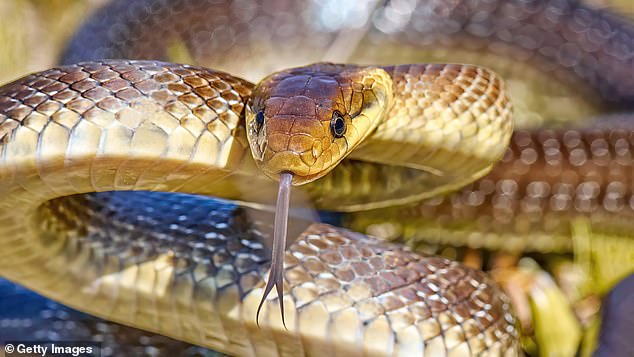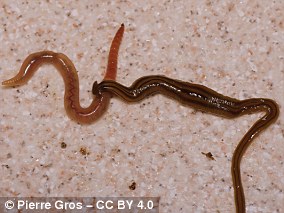If you have a fear of snakes, make sure you’re extra careful next time you head up to the attic.
Scientists have warned that 6.5-foot-long snakes are ‘thriving’ in the UK – and they love to make their homes in our houses.
A new study found that Europe’s biggest snake, the Aesculapian snake, has established a healthy population in parts of North Wales after two ‘accidental’ introductions.
Worryingly, scientists say the snakes’ ‘trump card’ for surviving the UK’s colder climate is to warm up inside our attics and walls.
Before you panic, there’s good news.
Thankfully, Aesculapian snakes are non-venomous and mainly feed on small rodents like rats and mice.
Professor Wolfgang Wüster, a snake scientist from Bangor University and co-author of the study, told MailOnline: ‘Any dog, even the smallest, could easily kill an Aesculapian snake, and rabbits are much too big to serve as prey.
‘The largest prey item they would normally eat would be the size of a large mouse or vole.’

Aesculapian snakes are not entirely new to the UK, as the fossil record shows that they were once native here.
However, during an Ice Age, the British population was wiped out, and they have not been seen in the country for around 300,000 years.
Their normal range extends over southern Europe from Spain to the Caucusus, but scientists say their ‘climate envelope’, the set of conditions they find comfortable, is now shifting further north.
This means that even as the snakes’ populations plummet in Europe, they are thriving in parts of the UK.
Currently, Britain’s Aesculapian snakes can only be found along the Regent’s Canal, London, and around Colwyn Bay, Wales.
The snakes were introduced to Wales in the 1970s when an ‘unknown number of individuals’ escaped from the Welsh Mountain Zoo after their enclosure collapsed.
Since then, these escapees have established a stable breeding population in the area surrounding the zoo.
But, given that these snakes are more commonly found in the balmy south of France, researchers were unsure how they were surviving the cold Welsh weather.
In a study, published in PLOS One, Dr Tom Major and his co-authors caught 21 Aesculapian snakes and fitted them with radio trackers before putting them back where they found them.
By following their movements over two summers, they found that the snakes were surviving by warming up inside human residences.
The researchers write: ‘We observed Aesculapian snakes actively seeking and returning to use inhabited buildings, and climbing large structures to access the attics and wall cavities of houses.’
Male snakes were particularly fond of human homes, while females generally preferred to live in wooded areas.
The researchers point out that this behaviour is very unusual compared to other UK snake species like adders and smooth snakes which typically avoid built-up areas.
Writing in The Conversation, Dr Major said ‘They were frequently entering buildings – relatively warm refuges – while they were digesting food or preparing to shed their skin.
‘They also used garden compost bins for shelter and to incubate their eggs.’
Luckily, while these large snakes might look fearsome, they don’t pose any threat to you or your pets.

Even within its native range, Professor Wüster points out that there has never been a report of an Aesculapian snake harming a pet.
In fact, a number of the tracked snakes were ultimately killed by native wildlife and pets including a buzzard and a house cat.
‘Aesculapian snakes are of course perfectly harmless and can just be picked up – even if they bite, the worst consequence would be some very minor scratches. Gardening gloves and a long-sleeved shirt would prevent even that,’ says Professor Wüster.
However, if you do find a snake in your home Professor Wüster says the best thing to do is call the RSPCA rather than risk trying to remove it yourself.
During their study, the researchers found that most residents did not mind the snakes and most never even noticed their presence.
Likewise, the snakes were found to co-exist well with the normal suburban wildlife and there was no indication that native species were suffering due to their presence.
The Government will soon consider adding the Aesculapian snake to the list of alien species of special concern, which would be grounds for their eradication.
However, even though Aesculapian snakes are technically an invasive species, the researchers are calling for the Government to protect them.

They argue that, as climate change shifts species’ climate envelope, conservationists should focus on protecting species in the territories they can actually survive.
Recent studies have shown that the number of Aesculapian snakes has fallen sharply in France, with climate change being a likely cause.
Therefore, the researchers argue that it makes more sense to protect Aesculapian snakes in the UK to prevent the species from being forced into extinction.
Professor Wüster says he would either like to see the UK’s two populations of Aesculapian snakes given the same protections as native species or simply be left alone.
Professor Wüster says: ‘It would be both a tragedy and a travesty if we eradicated a harmless species that is now thriving in only a couple of places in the UK when the same species is threatened and declining just a few hundred miles away in continental Europe.
‘With major climate change pretty much locked in and no sign of humanity doing anything about it, the old certainties of native vs. non-native are just no longer appropriate, so we should adapt.’

